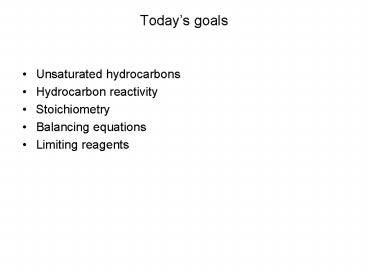Todays goals - PowerPoint PPT Presentation
1 / 14
Title:
Todays goals
Description:
Unsaturated hydrocarbons. Hydrocarbon reactivity. Stoichiometry. Balancing equations ... Stoichiometry more chemical accounting. C2H2 2 H2 -- C2H6 (balanced) ... – PowerPoint PPT presentation
Number of Views:54
Avg rating:3.0/5.0
Title: Todays goals
1
Todays goals
- Unsaturated hydrocarbons
- Hydrocarbon reactivity
- Stoichiometry
- Balancing equations
- Limiting reagents
2
Admin stuff
- OWL Ch. 4 OWLs due on Monday
- Test on Mon, Oct 2 6-730 PM, BART 65
3
MoleculesPutting atoms together
4
Saturated vs unsaturated hydrocarbons
http//scholar.hw.ac.uk/site/chemistry/activity3.a
sp?outline
5
Alkynes triple bonds
- When our hydrocarbons have triple bonds, they are
named with -yne instead of -ane. - Triple bonds result in 180 deg (linear) bond
angles
6
Reactivity of alkenes and alkynes
- Additions of H2, Cl2 or HBr, or HOH (11.4 on CD)
- Elimination reverse of addition (11.6 on CD)
- Combustion with O2 possible for ALL alkanes
7
Combining moleculesStoichiometry and reactions
8
Stoichiometry more chemical accounting
- C2H2 2 H2 --gt C2H6 (balanced)
- What makes this a balanced reaction?
- Same of atoms of each element on both sides
- It follows that the total mass on each side must
be balanced
9
Stoichiometry more chemical accounting
- C2H2 2 H2 --gt C2H6 (balanced)
- How many molecules of C2H2, H2, and C2H6 are
involved in this reaction? - How many moles of C2H2, H2, and C2H6 are involved
in this reaction? - How many grams of C2H2 and H2 are needed to
produce 1.36 grams of C2H6?
10
Stoichiometry more chemical accounting
1 2 1 ratio of
moles (and molecules)
26.0379 2.0158 30.0694 (molar mass, g/mol)
- C2H2 2 H2 --gt C2H6 (balanced)
- How many molecules of C2H4, H2, and C2H6 are
involved in this reaction? - What mole ratios of C2H4, H2, and C2H6 are
involved in this reaction? - How many grams of C2H4 are needed to produce 1.36
grams of C2H6? - How many grams of H2 are needed to produce 1.36
grams of C2H6?
1.18 0.182
1.36 (grams)
0.0452 (moles)
0.0452 0.0905
11
A reaction defines our stoichiometric ones
26.0378 36.461 98.959 (Molar masses)
- C2H2 2 HCl --gt C2H4Cl2 (balanced)
- What mole ratios of C2H2, HCl, and C2H4Cl2 are
involved in this rxn?
These are our stoichiometric factors
- How many grams of HCl and C2H4Cl2 are involved in
a complete reaction with 3.46 g of C2H2?
9.69 g HCl
13.15 g C2H4Cl2
(0.133 moles of C2H2 didnt need to
explicitly calculate)
12
How to balance chemical equations
- C3H8O O2 --gt CO2 H2O
(1) Identify the components that need to be
balanced
(2) Pick one that exists in only one species in
each side and balance it
(3) Save components that exist in isolation for
last, balance more prevalent components earlier
(4) Double-check final tally! All numbers should
be integers.
13
Limiting reagent (non-stochiometric quantities)
30.069 31.999 44.010 18.015
(Molar mass, g/mol)
- 2 C2H6 7 O2 --gt 4 CO2 6 H2O (Balanced)
- If 1.00 g of C2H6 and 5.00 g of O2 are reacted to
produce CO2, which reactant is limiting?
- Two ways to answer this question
- How many moles of CO2 can be produced?
- How do the mole ratios of reactants compare to
the stoichiometric ratio?
14
Limiting reagent (non-stochiometric quantities)
30.069 31.999 44.010 18.015
(Molar mass, g/mol)
- 2 C2H6 7 O2 --gt 4 CO2 6 H2O (Balanced)
- If 1.00g of C2H6 and 5.00g of O2 are reacted to
produce CO2, which reactant is limiting? - How many moles of CO2 can be produced?
We have enough C2H6 to produce 0.0665 mol CO2
We have enough O2 to produce 0.0893 mol CO2
0.0665 mol CO2

